Water Heaters
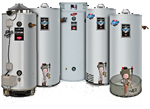
Gas (Natural) Water Heating
Residential gas:
- RG130T6N
- RG140T6N
- RG150T6N
- RG230T6N
- RG230S6N
- RG240T6N
- RG240S6N
- RG250L6N
- RG250T6N
- RG250S6N
DEFENDER SAFETY SYSTEM®
Atmospheric Vent Gas Models
Bradford White's Defender System Atmospheric Vent water heaters utilize a draft diverter and are atmospherically vented with capacities ranging from 30 to 50 gallons and inputs ranging from 30,000-50,000 BTU/Hr. Defender Atmospheric Vent models are perfect for many standard water heating applications
Bradford White ICON System™ Features
- Enhanced Performance
- Advanced Temperature Control System
- Intelligent Diagnostics
- Pilot On Indication
- Green LED
- Separate Immersed Thermowell
Standard Features
- Advanced ScreenLok® Technology Flame Arrestor design
- Resettable thermal switch
- Maintenance free
- Pedestal base
- Sight window
- Factory installed Hydrojet® Total Performance System
- Vitraglas® lining
- ¾" NPT factory installed dielectric waterway fittings
- Protective magnesium anode rod
- "3" x "4" Snap-Lock draft diverter on 40,000 BTU/Hr. or less models
- T&P relief valve included
- Brass drain valve
- 1" Non-CFC foam insulation
Power Vent (TTW®)
Gas Models
Residential Gas:
- RG1PV40S6N
- RG2PV40S6N
- RG2PV40T6N
- RG1PV50S6N
- RG2PV50S6N
- RG1PV55H6N
- RG2PV40T6N
- RG2PV50T6N
- RG2PV75H6N
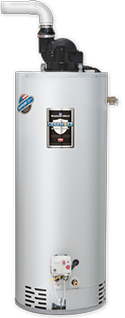
Our Power Vent (TTW®) models are power vented for positive exhaust. They offer greater installation flexibility with the ability to vent through a wall or roof, with either 2" or 3" PVC, ABS or CPVC pipe. They offer an increased amount of hot water available at a usable temperature in less time than normal.
Features
- Advanced ScreenLok® Technology Flame Arrestor Design
- Flammable vapor sensor
- Pedestal base
- Maintenance free
- Sight Window
- Powerful blower motor
- 3/4" NPT factory installed dielectric waterway fittings
- Power Vented Water Heater
- Spark to pilot ignition system
- Horizontal and Vertical Venting
- Vitraglas® lining
- Protective magnesium anode rod
- Factory installed Hydrojet® Total Performance System
- 1" Non-CFC Foam Insulation
- Honeywell Self Diagnostic Electronic Control
- Brass drain valve
- T&P relief valve included
Electric Water Heating
Electric Water Heating Residential Electric - Upright:
- RE330S6
- RE340S6
- RE340T6
- RE350S6
- RE350T6
- RE240S6
- RE250S6
Upright Electric Models
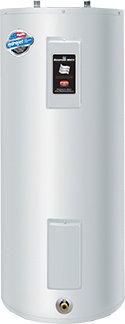
Our line of upright electric models features the power of the Hydrojet® Total Performance System and the convenience of electricity. Available in single and double element models, these water heaters give you the power you need to heat water with electricity.
Features
- Direct heat transfer with immersed screw-type elements
- Fully automatic controls
- Factory installed Hydrojet® Total Performance System
- Factory installed dielectric waterway fittings
- Protective magnesium anode rod
- Vitraglas® lining
- Heat traps
- T&P relief valve opening
- 2" Non-CFC foam insulation
Lowboy Models
Residential Electric - Low-Boy:
- RE120L6
- RE230L6
- RE240L6
- RE250L6
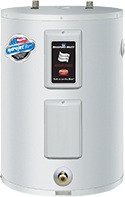
Residential Electric models, with their varied configurations, fit just about any location. Built for tight spaces with low headroom, Lowboy models allow you flexibility to put electric water heating where a conventional upright tank will not fit.
Features
- Fully Automatic Controls
- Hydrojet® Total Performance System
- Direct Heat Transfer with Immersed Elements
- Optional Conversion Kits Available
- Lowboy Models Provided with Insulation Wrap
- Vitraglas® Lining
- Max Temp - 160°F
- 3/4" NPT Dielectric Waterway Fittings
- T&P Relief Valve Installed
- Protective Magnesium Anode Rod
- 1" Non-CFC Foam Insulation
- 6-Year Tank and Parts Warranty
Utility Electric Models
Residential Electric - Utility:
- RE16U6
- RE110U6
- RE112U6
- RE112T6
- RE115U6
- RE120U6
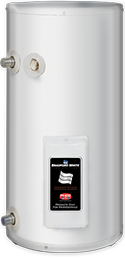
These compact models are, as the name implies, utility water heaters that provide smaller volumes of hot water where usage is intermittent or demand is lower.
Features
- Direct heat transfer with immersed element
- Fully automatic controls
- Vitraglas® lining
- Factory installed dielectric waterway fittings
- Protective magnesium anode rod
- T&P relief valve opening
- 1" Non-CFC foam insulation
Manufactured Home Residential Gas
Manufactured Home Direct Vent Gas Models
- RG2DVMH30T6X
- RG2DVMH40T6X

As with the energy saver atmospheric combustion model, its direct vent counterpart is also designed for mobile homes. This version takes combustion air in from outside and then vents combustion gases directly back outside.
Features
- Fully automatic controls
- Closed combustion vent kit package for installation flexibility
- Vitraglas® lining
- Factory installed dielectric waterway fittings
- Protective magnesium anode rod
- T&P relief valve opening
- Brass drain valve
- 1" Non-CFC foam insulation
Frequently Asked Questions
What does the Energy Factor (EF) on my water heater mean?
The water heater Energy Factor (EF) is a measure of the overall efficiency of the water heater. This is determined by comparing the energy in the heated water used daily to the total daily energy consumption of the water heater. The EF can be used to compare the energy efficiency of water heaters. Water heaters with higher EFs will have lower annual operating costs than comparable models with lower EFs. A higher EF signifies a more efficient model. Water heaters with high EF ratings may cost more initially, but save energy and money in the long run. Eventually, they will pay for themselves through a lifetime of energy savings.
Where is the "anode rod" and what does it do?
For most water heaters, the anode rod is attached to the hot water outlet of the water heater. If you are facing the front of the water heater (where the labels are), the hot water outlet is on the left hand side. The anode rod is often referred to as a "sacrificial rod".
Most water is rarely "pure". It can contain oxygen, magnesium, fluoride, chlorine and suspended particles. These components, in the concentrations in your water, are usually not bad for you. However, they do contribute to the taste and smell of the water. They also impart a slight conductivity to the water. Through an electrical process called electrolysis, this conductivity will eventually (over a long period of time) cause most metal to rust or corrode. When the water is heated, this electrical process can be accelerated.
Most water heaters are made of a steel tank with a porcelain enamel (glass) lining. However, due to production and assembly methods, it is not always possible to completely cover the inside of the tank. Therefore it is important to provide metal that can be consumed by the electrical process. This is where the sacrificial anode rod comes in. By acting as a lightning rod for the corrosion process, the anode rod draws the harmful electrolytic process away from the water heater tank and focuses the corrosion on the anode rod. Water heaters need this sacrificial anode rod to ensure that the electrolysis does not affect the tanks.
Why doesn't my old water heater make as much hot water as it used to?
The answer may be that you have sediment buildup in your tank. As water heaters age, they tend to accumulate sediment and lime deposits. If the heaters are not cleaned periodically, the sediment may rise to a level that will act as a barrier between the burner and the water, making it harder to heat. An article published in a national ASPE plumbing journal states: for every half inch of sediment on the bottom of a gas fired water heater, it requires up to 70% more fuel to heat the water.
If my water heater was in a flood, do I need to replace it?
Yes. The Air-Conditioning, Heating and Refrigeration Institute (AHRI) recommends that any flood-damaged heating and cooling equipment be replaced, not repaired. From the AHRI website, as it pertains to water heaters:
"Whether your water heater is gas-fired, oil-fired or electric, if it was exposed to flood water, the unit should be replaced. In a gas unit, valves and controls will likely corrode. In an electric unit, the thermostat and controls will likely corrode. In both types, the insulation surrounding the unit will be contaminated and will be nearly impossible to disinfect. Additionally, the insulation would take a long time to dry, leading to corrosion of the tank from the outside.
Even if water heater components have been cleaned and the unit seems to operate properly, parts may corrode in the future. Both gas and electric water heaters have a pressure relief valve that can corrode and stick after being exposed to flood water. Therefore, be sure to replace this valve as well."
(Taken from www.ahrinet.org)
At the suggestion of AHRI, be sure to have your inspection and replacement work performed by a qualified professional.
Can I use my water heater with a solar heating system?
With the increasing costs of energy and a desire for environmental friendliness, some customers are turning to the sun as a way to heat their domestic water. Bradford White manufactures a solar water heating storage tank for use with solar systems. This tank takes the heated water from the solar panels and uses it as a heat source instead of conventional gas, oil or electric heat sources unlike other tanks, this water heater has an electric heating element for back up on cloudy days, and when the solar system is not providing enough heat. However, it is important that you use only POTABLE (or domestic use) water in this tank.
Is a drain pan necessary?
A water heater should be placed in an area that will prevent damage to floors, ceilings, and furniture if the heater leaks. When this is not possible, a drain pan must be installed under the water heater. Since a typical drain pan doesn't hold that much water, it must have a pipe to a drain or other outlet for the water. When installed properly, a drain pan and pipe will keep any leakage under control and protect your belongings from water damage.
What type of maintenance should I do on my water heater?
We recommend that you contact a plumbing professional to perform any maintenance or repairs to your water heater - from periodic checks on the anode rod to ensuring that all connections are secure. Recommendations for maintenance are in your water heater's owner manual. However, there are a few things that you can do:
- Ensure that there are no sources of flammable vapors in the same area as your water heater (this includes gasoline, heating oils, lighter fluid, propane, etc.).
- Keep the top of the water heater clean. If you notice water dripping on the water heater from any piping, contact a plumbing professional to have the leak repaired.
- Keep the space around your water heater clean and free of dirt, boxes, paint cans, aerosol cans, household cleaners and trash. It is important to keep the heater accessible for proper operation and easy maintenance.






